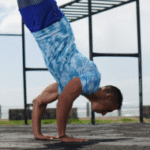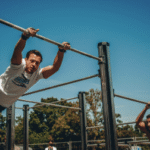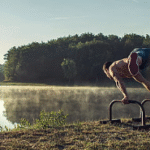How Private Calisthenics Adapts to Your Unique Fitness Level
The Foundational Principle: Infinite Scalability of Calisthenics
The core strength of calisthenics lies in its scalability. Every bodyweight exercise can be made easier (regressed) or harder (progressed) by manipulating variables such as:
Leverage: Altering the body’s position relative to the pivot point (e.g., incline push-up vs. regular push-up, or tucked planche vs. full planche).
Range of Motion (ROM): Decreasing or increasing the distance of movement (e.g., box squats to deep squats).
Stability: Training on a stable surface vs. an unstable one (e.g., floor push-ups vs. rings push-ups).
Assistance/Resistance: Adding external help (resistance bands for pull-ups) or external weight (weighted vests for dips).
Unilateral/Bilateral: Training with two limbs vs. one (e.g., two-leg squat vs. pistol squat).
A private coach expertly leverages this principle to create a perfectly customized training stimulus.
—
How Private Coaching Adapts to Your Unique Fitness Level (Detailed Mechanisms)
A private calisthenics coach in Houston employs a multi-faceted approach to adapt your training, ensuring optimal progression and safety:
- 1. Precise Initial Assessment (The Starting Point for Adaptation):
Detail: The journey begins with a comprehensive evaluation. Your Houston-based coach conducts a thorough health and fitness history intake, followed by a detailed physical assessment. This includes:
Movement Screening: Observing fundamental patterns like squatting, pushing, pulling, and hinging (e.g., a simple bodyweight squat, or an overhead reach) to identify any limitations, imbalances, or compensatory movements. This helps uncover the root cause of potential issues.
Mobility Tests: Assessing the active range of motion in key joints (e.g., shoulder flexion for overhead movements like handstands, wrist extension for ground-based skills like planche, hip flexion for deep squats).
Foundational Strength Tests: Evaluating your current strength levels in various pushing, pulling, and core exercises (e.g., how many incline push-ups you can do, duration of a plank hold, assisted pull-up capacity, L-sit progressions). These tests are often regressed to find your true starting point, ensuring safety.
Injury History Discussion: past or current injuries (e.g., common shoulder or knee issues from sports or work) that require specific adaptations.
How it adapts: This granular assessment pinpoints your exact current capabilities and limitations, allowing the coach to meet you precisely where you are and design a program that is challenging yet safe and achievable.
- 2. Customized Progression & Regression Design (The Core of Adaptation):
Detail: This is the most crucial aspect of adaptation. Your coach selects specific variations of exercises to perfectly match your unique strength and skill level, ensuring you’re always training effectively without being overwhelmed or under-challenged.
For Absolute Beginners: The focus is on fundamental regressions to build basic strength and body awareness safely. Examples: Wall push-ups or incline push-ups (using a counter/bench), Australian rows (inverted rows on a low bar), box squats to a high chair, band-assisted pull-ups , and basic plank holds . The emphasis is on perfecting basic movement patterns before advancing.
For Intermediate Individuals: The program transitions to standard variations and early skill prerequisites. Examples: Full push-ups , unassisted pull-ups (focusing on increasing reps/sets), pistol squat negatives or box pistol squats , L-sit progressions (from tuck to one-leg or straddle), and tricep dips .
For Advanced Athletes: The program focuses on challenging progressions for complex calisthenics skills and advanced strength. Examples: One-arm push-ups , muscle-ups (strict or kipping), freestanding handstands and handstand push-ups , planche progressions (tuck, advanced tuck, straddle), front lever progressions , and weighted calisthenics (adding external load to pull-ups, dips, push-ups).
How it adapts: This ensures continuous growth. The coach designs a clear pathway, always providing the right level of challenge, preventing frustration and promoting consistent advancement.
- 3. Tailored Volume & Intensity (Adapting the Stimulus):
Detail: Beyond just exercise choice, your coach customizes the total work (sets, reps) and effort level (using RPE – Rate of Perceived Exertion) based on your individual recovery capacity and fitness level. Beginners typically start with lower volume and moderate intensity; advanced athletes can tolerate and benefit from higher loads and volumes.
How it adapts: This ensures you receive the right amount of stimulus for continuous growth without leading to overtraining or insufficient challenge, optimizing recovery for your specific body.
- 4. Strategic Exercise Selection (Matching Exercises to Level):
Detail: Your coach meticulously chooses movements that are not only appropriate for your current level but also specifically target your identified weaknesses or imbalances.
How it adapts: This prevents frustration for beginners (avoiding exercises too hard) and boredom for advanced (avoiding exercises too easy), making every workout purposeful and engaging.
- 5. Dynamic Adaptation (Real-time Responsiveness):
Detail: A truly personalized program is not static. Your coach continuously monitors your performance in each session, your energy levels, and your recovery.
How it adapts: If you’re progressing quickly, they’ll immediately increase the challenge. If you’re feeling fatigued (e.g., from a demanding work week in Houston or inadequate sleep) or encounter a minor setback, they can scale back the intensity/volume or implement a deload week. This constant responsiveness ensures continuous forward momentum and prevents plateaus.
- 6. Meticulous Form Correction (Safe Adaptation):
Detail: The one-on-one setting allows for constant, precise form feedback. Your coach identifies and corrects subtle compensation patterns that might arise as you adapt or attempt harder variations. They use verbal, visual, and sometimes tactile cues.
How it adapts: This is crucial for all levels. For beginners, it builds safe fundamental movement patterns and prevents bad habits. For advanced, it refines technique for complex skills, preventing injury as load and complexity increase.
- 7. Mobility & Corrective Exercise Integration (Addressing Individual Limitations):
Detail: Your coach integrates tailored mobility drills and corrective exercises into your program to address your specific limitations (e.g., tight shoulders hindering an overhead press, weak wrists affecting handstands, or stiff hips impacting deep squats).
How it adapts: This adaptation unlocks your potential by systematically removing physical roadblocks unique to your body, ensuring a holistic approach to your fitness.
—
Benefits of This Adaptation for the Client:
Consistent Progress: You’re always challenged optimally, preventing plateaus and maintaining motivation.
Reduced Injury Risk: Training is scaled precisely to your body’s readiness, minimizing strain and promoting longevity.
Increased Motivation: Achieving consistently appropriate challenges keeps you engaged and confident.
Efficient Training: Every minute is productive because the workout is designed exactly for your body and goals.
Personalized Challenge: You’re never bored or overwhelmed, ensuring long-term adherence.
Houston Context:
Houston’s diverse population and varied lifestyles (from desk jobs to active outdoor pursuits, potential pre-existing injuries from local sports) mean clients come with a wide range of starting fitness levels and unique physical histories. The adaptability of private calisthenics coaching is perfectly suited for this environment. Whether you train in a specialized studio (like Calisthenics & Lifestyle Club Houston), utilize Houston’s expansive public parks with outdoor fitness areas, or prefer your home gym, your coach can tailor the environment to your program, ensuring maximum effectiveness.
—
Conclusion: The Power of Personalized Adaptation
Private calisthenics training offers a uniquely powerful and effective pathway to fitness because it is inherently designed to adapt to your unique fitness level . Through precise initial assessments, customized progression and regression strategies, tailored volume and intensity, and dynamic adjustments, a dedicated coach in Houston ensures that your training is always challenging, safe, and perfectly aligned with your body’s specific needs. This unparalleled adaptability is the secret to consistent progress, injury prevention, and ultimately, achieving your full physical potential in calisthenics.

How Private Calisthenics Adapts to Your Unique Fitness Level
Route
Calisthenics Gym Houston Functional Bodyweight Training
Secondary phone: (346) 483-3195
Email: info@calisthenicsclubhouston.com
URL: https://calisthenicsclubhouston.com/
Monday 6:00 AM - 7:00 PM Tuesday 6:00 AM - 7:00 PM Open now Wednesday 6:00 AM - 7:00 PM Thursday 6:00 AM - 7:00 PM Friday 12:00 PM - 6:30 PM Saturday 9:45 AM - 12:00 PM Sunday 3:00 PM - 5:00 PM





